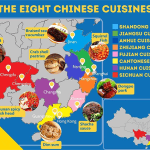
As the only ancient town forming part of greater Shanghai, with a history spanning over one thousand years, Qibao is more than just a living fossil of ancient Chinese conurbation and urban planning. The town was built in Northern Song Dynasty (960-1126) and grew into a prosperous business center during Ming (1368-1644) and Qing Dynasties (1644-1911). Qibao is the Chinese for ‘seven treasures’ and there are two popular theories about its derivation. The more reliable one says that the name originates from the Qibao Temple, famed for its good reputation. It was this that contributed to the growth of business and culture of the previously unknown town. The old street in the heart of the tiny town is the epitome of old Shanghai. The street has been restored to its original look which is consisted of two sections, southern and western lesser streets. The southern part filled with traditional restaurants serving various tasty snacks is a paradise for gourmets (měi shí jiā 美食家). Old shops selling art crafts, antiques and calligraphy (shū fǎ 书法) works occupy the western part. In this part visitors will find the Qibao Pharmaceutical stores (yào diàn 药店), a-thousand-year-old shop, some fine tea houses, and Shadow Play Opera theaters. The small town is a good place to explore Shanghai’s grand past. When traveling there, watch out for the authentic flavors.
Qibao Shadow Play (pí yǐng xì 皮影戏) Shadow Plays were once a feature of Shanghai culture but it was a man named Mao Gengyu from Qibao Town who first introduced this art to Shanghai area. The Qibao Shadow Play performs mainly entertainments based on widely-known historical events with the local dialect, thus giving the shows a truly local character. The plays are performed using colorful drawings and expressive music to illustrate the emotions of the characters.
Qibao Snacks A great variety of snacks will attract your eye and tempt your appetite when you are walking the streets of the old town. Colourful and appetizing, few resist the temptation to try them. Different flavoured cakes made from polished glutinous rice (nuò mǐ 糯米) ‘Qibaogao’, dried bean curd wrapped in lotus leaves (hé bāo dòu fǔ gān 荷包豆腐干), roasted sweet potatoes (kǎo hóng shǔ 烤红薯), smoked toads (xūn lài há ma 熏癞蛤蟆), and sugar coated haws on sticks (táng hú lu 糖葫芦), etc. can be found on every corner in Qibao Town. Within this area of 21.3 square kilometers that forms the ancient streets and a newly developed district, Qibao Town carries visitors back through the centuries by virtue of its history, culture, architecture and local people.
A day spent in this unique and historic town will be very rewarding and is highly recommended.
Qibao Crickets Once it was one of the most popular folk activities among the ancient Chinese and even now cricket fighting still draws so much interest that the local people have established a special museum where both cricket displays and live cricket fighting shows are to be seen. It may seem strange that such a little insect could bring great popularity to a place, but the crickets in Qibao Town, especially the fiercest species called Iron Sand and Blue (respectively referring to the colors of their necks and feet), are indeed an extraordinary and indispensable feature of the town. Due to its favourable geographic position and fertile lands, the town provides the crickets with an abundance of food and ideal living conditions. In return, the vigorous crickets provide exciting performances each day during the golden weeks (May 1-7 and Oct. 1-7) and the annual Festival of Cricket Culture.
Qibao Temple (qī bǎo sì 七宝寺) One of the most important sites of this ancient water town is Qibao Temple, said to bring the town luck and prosperity. It’s difficult to say if it was the town that inspired the name of the temple or vice versa. The temple was built to house seven treasures – the iron Buddha, the bronze bell, the golden lotus sutra, a 1000 year-old catalpa tree, a jade axe, a gold cockerel, and a pair of jade chopsticks. Sadly, the original temple is no longer standing – the current building was built in 2002 – and only two of these treasures remain. Still, the new Qibao Temple covers 155 acres and is a lovely collection of halls and gardens.




















